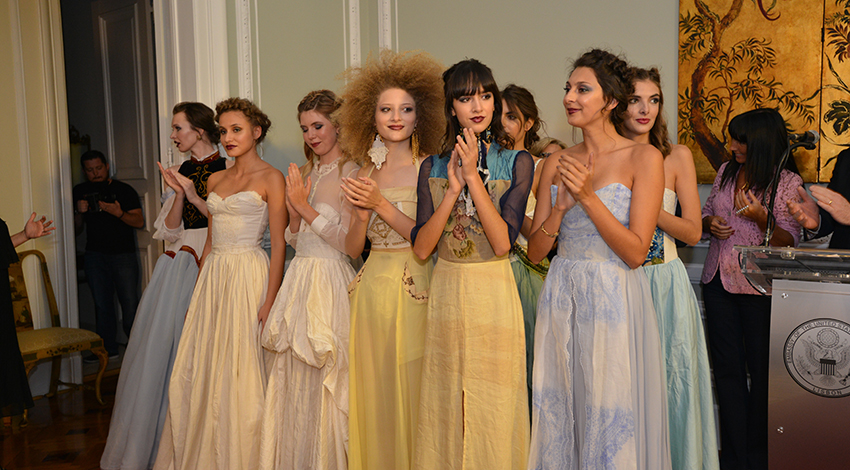Madeiran embroidery has turned from table cloths and bedsheets to the catwalks thanks
to the endeavours of North American fashion designer Jeff Garner.

At the Embassy of the United States of America in Lisbon, guests spread around a few halls transformed into catwalks. This unlikely place served as stage for the presentation of a collection which is the outcome of an equally unlikely partnership between Madeira and North American fashion designer Jeff Garner.
The basis for this symbiosis is Madeiran Embroidery, a traditional craft renowned for its beauty in some international markets since the 19 th century. But long gone are the days of table cloths and linen that lasted for a lifetime. Madeira wants to add an aspect of modernity to its tradition and invested on Jeff Garner as a gateway to the American market, which has historic commercial connections to the island, perhaps best illustrated by the fact that the signing of the declaration of the independence was toasted with Madeira Wine.
Alongside wine, embroidery is an ambassador for Madeira and it needs to gain more space for itself if this traditional craft is to be kept alive. In the past, embroidery was done by 100 thousand women on the island. Nowadays, they are about 300. When the craft was born almost 200 years ago, it was applied to fashion. In a sense, this new stage almost qualifies as a return to its roots.
‘Atlântico’ is the name of the collection which is the most recent realization of an investment in modernisation which has involved partnerships with international brands and the commitment of some producers. Jeff Garner tells Essential how this collection defines ‘a past of maritime exploration’. ‘The indigo blues shades blend with marigold yellows to create teals along with emerald shades and ivory hand embroidered lace from ancient Irish linens adore this collection from Madeira”.
Some of the ensembles showcased in the rooms of US Embassy in Lisbon were created from unique pieces of fabric, such as table cloths. ‘Some times, the fabric comes first and helps to shape the dress’, explains the designer. And one of the ‘ball gowns is made from a table cloth that took more than six months to embroider.’
The launch of this collection met the expectations of IVBAM. According to its president, Paula Jardim, the goal was to ‘take Madeiran Embroidery beyond its horizons, reaching more and more international markets.’ The idea behind this is to make it be seen as ‘an artisanal product of great prestige, luxury and quality which ought to be preserved’, she adds.
From Lisbon the collection flew to Copenhagen and then to Los Angeles, Charleston, where it was photographed, the Perth Eco Australia Fashion Week.
Jeff Garner says the public has taken to it: ‘I think everyone was inspired to see Madeiran Embroidery be part of a new concept’. But this is a promotional campaign. Could fashion be a solution for this product? The fashion designer thinks that Embroidery has ‘a unique fabric, it is sewn by hand and has a beautiful history’, all of which are ingredients for success.
Times were challenging: ‘just three months to prepare 30 ensembles for the catwalk and with no budget’. The work was done for the single goal of promoting the craft.
To prepare this collection, Jeff Garner visited Madeira. Here he drew inspiration from the colours and fell in love ‘with the beauty of the details’ of the production process. ‘I gathered all the fabrics I could find and went back to Tennessee to embark on the voyage of creating ‘Atlântico’, presented to the world by his brand, Prophetik, in the halls of the US Embassy in Lisbon.














